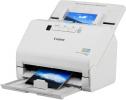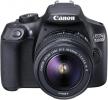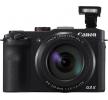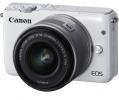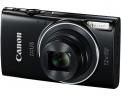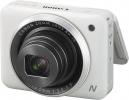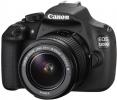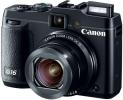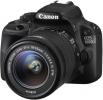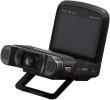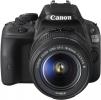Reviews related to : Canon Cameras
Canon have long had a reputation for innovative camera technology, taking their experience in hi-end SLR arena into the digital age.
We've reviewed many Canon products over the years from camcorders to compact digital and full SLR digital products.
If you're looking for a good digital camera then Canon are definitely worth a look. Why not browse through the reviews below?
While these days the vast majority of images are taken on peoples phones it’s not that many years ago that they were taken on cameras and only a little longer ago they were taken on film with a negative that gave a printed image. So there are still a great number of irreplaceable images that exist only as a printed photograph and each time they are taken from an album the chance of damage happening is increased so get an image now while you still can.
The Canon imageFORMULA RS40 Photo and Document Scanner measures 31cm wide, 17cm from front to back although this increases to 36cm when the receiving tray is extended and 26cm tall. There are folded sheets with Getting Started instructions in several languages. Basically remove the tape and one orange plastic shield.
This is a small but very power DSLR kit supplied with an 18-55mm lens. I always enjoy my testing of such items as once past the initial learning curve – when I use the Auto settings – in whatever review time remains I extend myself with the range of manual mode choices.
It is 12.5x10x14.5cm the last figure with the lens at its most compressed position, the total weight is 696grams. It is supplied with a neck strap but the normal substantial grip point on the right side I prefer to use it without it. The left side has an anchor point for the neck strap with a rubber bung covering a charge port, USB port and HDMI out socket. The right side has the pair to the neck strap anchor.
This is Canon’s entry level range but do not make the mistake of thinking they are basic units. Canon’s technology filters down and things that would only be in a high end unit a few years ago are now on something that can fit into a small pocket.
As always I start in Auto mode and right from the first image you know that you have hold of a more than decent unit. It is 9.5x5.3x2.2cm the last figure when closed this can increase by another 3cm when the unit is fully zoomed. It weighs 126grams.
The PowerShot range is only one step down from their DSLR offerings; however they are small enough to fit in your pocket but are still extremely powerful units that have a large number of features that started out in their DSLR models.
The Canon website says ‘DSLR-like creativity in a connected large sensor compact’ which seems to sum up this powerful unit. It is small enough to fit in your pocket or purse at 10.5x6.5x4cm the last figure increase to 8cm when fully zoomed. It is somewhat heavier than a standard digital camera at 318grams. A novice user could turn the nine position wheel on top of the unit to ‘Auto’ and get very respectable images via point and shoot but this unit offers so much more.
Canon do three ranges of cameras the IXUS the smallest, next is the PowerShot and finally their DSLR range. However the area between the last two is somewhat grey, this PowerShot is considerably larger in size than a small DSLR.
The Canon PowerShot G3X measures 12cm wide, 8cm deep and 11cm from the screen to the front of the lens when closed however when fully zoomed this last figure increases to 17cm. So with that amount of optical zoom (25x) you will not be surprised that it weighs a good bit more than most PowerShot offerings at 738grams. Of course all recent cameras have to have the ability to take selfies so the TFT can flip through 180 degrees to show above the camera.
This is one of a new variety of cameras that have interchangeable lenses but are still almost small enough to fit into a pocket, yes they are therefore a DSLR but probably not considered so by the purist. Meet the Canon EOS M10 which is a mirrorless camera.
Canon describe the EOS M10 as a ‘a compact system camera that combines DSLR performance with effortless portability.’ It is 10.5x6.5x8.5 when the 15-45mm lens in locked shut, it weights 438grams. It comes with a neck strap but I preferred using it in the hand. In deference to those whose life would end without the ability to take a Selfie the TFT swings through 180 degrees to allow this process to take place.
Anyone who wants a very easy to use camera that takes extremely good images and can also take video from a unit which can slip into even the smallest pocket, should be looking at the Canon IXUS range and this tiny offering is no exception.
The Canon IXUS 275 compact digital camera measures 10x5.5x2cm, the last figure can increase by another 3.5cm when the lens is fully extended. The camera weights a tiny 144grams. The left side is clear, the right side also looks the same apart from the anchor point for the supplied wrist strap until you look closely when you see it is a cover behind which there are mini HDMI and AV sockets.
A change in how review loans are authorised is the reason that there has been an interregnum since the last review from me. Hopefully now I can get back to telling you about the latest offerings from this iconic name in cameras and more.
Canon are best known – and rightly so – for their professional and semi-professional DSLR units. They also do two small pocket camera brands the IXUS and the Power Shot. IXUS unit are always small and sometimes tiny, the size of the Power Shot units vary from as small as the IXUS to almost as large as a small DSLR. This unit, the G9X, is on the small end.
Certainly the smallest PowerShot I have ever seen or used. Its small size means that certain features are in different places. It uses a micro SD card and the TFT display takes all of the rear of the unit, yes it is small, small pocket small.
So while the PowerShot range is still considered to be more advanced than the IXUS this is as small in volume as most IXUS offerings. However even someone using a lot of cameras will need to think here as while finding the on/off is easy as is selecting either still or video mode both are on the side of the unit as are Wi-Fi connection and review on the TFT screen. How do you take a still image, for video you use the TFT to start and stop very easy but for still images this does not work.
The IXUS range are the nearest thing to a point and shoot camera from Canon who are best known for their high end DSLR cameras used by the majority of professional photographers. This is small fits easily in a pocket and is very easy to use.
The Canon Ixus 170 compact digital camera measures 9.8x5.5x2cm when closed; the last figure can increase by up to 4cm when the lens is fully extended. It weights 138grams. My unit was metallic blue but they do other colours. Just because it is small does not mean it lacks quality in fact it can capture images up to 20MP and they are excellent. You have only to choose the resolution L, M1, M2, S or W.
A small PowerShot digital camera, for those who do not know a PowerShot can be little larger than an IXUS the smallest of Canons cameras or as large as the small end of Canons DSLR range, so here it is at the IXUS end of the range.
The Canon SX610 HS measures 10x6x2cm and weights 190grams. The right side has a tight fitting door behind which are AV and HDMI out sockets, above this is a wrist strpap anchor point. The left side has a manual flash deployment button. The base has the solid battery bay which is where you insert any SD card you use, there is also a tripod screw which if you are going to use a lot of zoom is very important.
The Ixus is Canons pocket size camera range, it does however benefit from all the technology that its larger siblings have in terms of technology so do not reject this unit simply because its small enough to fit inside the smallest pocket.
The Canon Ixus 160 Compact Digital Camera measures 9.5x5.5x2cm and weights only 126grams. The right side has a rubberised edge which at the top lifts to reveal A/V out. In the centre is a clip to attach a wrist strap. The base has a tripod screw anchor and beside this the solid battery door and behind this is also where you place any SD Card you use. The left side is clear. The face has the 8x zoom lens and above and to the left of this the bar flash that cannot be nearer than 2CM to the lens.
Having recently looked at two DSLR units from Canon it is now time to try something smaller and lighter but the technology is still rife in this latest offering in the Canon PowerShot range, so what wonders does the G7X offer.
The Canon PowerShot G7X measures 10.5x6x3.8cm and weights 300grams, add 4cm to the last figure when the lens is fully zoomed. The right side has a flip door behind which are AV and HDMI connectors, below this is a flush button that will search for a Wi-Fi access point and behind the flip door is a strap anchor point. The left side also has an anchor point as well as the built in flash flip up button.
This DSLR is only a little larger than their most powerful PowerShot unit. It is a full featured DSLR capable of capturing very good images and for those that require it also capable of capturing very good video images as well.
The Canon EOS 1200D Digital SLR Camera measures 12.5x9.5x14cm and weights 684grams without the neck strap. While you would probably attach the neck strap for those occasions when you are wandering around for hours taking images I preferred it without it when I was removing it from my bag to take images and then moving on. The hand grip on the right side is comfortable and although the scales do not lie it feels comfortable when being held.
Another unit from Canons excellent PowerShot range. Here a small unit with periscopic zoom as this is a waterproof unit and this is essential for those wanting to takes images under water. It also takes excellent dry land images.
The Canon D30 digital camera measures 10.5x7x2/5cm and weights 210grams. My unit was metallic blue and black, the later mostly rubber with a thumb rest top left of the back and finger holds on the front. The right side has AV out and DC in both behind a door. The left side is clear, the base has tripod screw and a secure door behind which the solid battery is as well as any SD card you use. The front has the lens top left with the bar flash 1cm to its side.
This is a PowerShot offering which along with the Ixus brand are Canons two non DSLR offerings. This is one of the larger small units as such it is almost as large as some smaller DSLR units and it comes with a neck strap not a wrist strap.
The Canon PowerShot G16 compact digital camera measures 9.5x7.5x4cm, the last figure can double when fully zoomed. The unit weights 354grams. As with most recent offerings it has Wi-Fi to transfer images and of course to let you know where you took that great sunset. The right side has neck strap anchor point and a door behind which are connections for AV and HDMI so you can show your videos direct to your TV.
Perhaps a strange time of year to be sent a DSLR unit with a 55-250mm lens as this requires either very large rooms or outside use to get the best from it, however so far the weather has been kind and my short time with it was productive.
The body is 10.5x9x7cm, I am mentioning things this way as not everyone will use 55mm to 250mm lens with it. Add the lens and the last figure becomes between 18cm and 22cm. The total weight is 804grams (without neck strap). As always I start with it in the easiest mode ‘Auto’ and assume that I know nothing.
Most cameras that I review are still units that have the ability to take movies. This is almost the reverse being a unit most likely to be used to take video but it can also take still shots however this is fixed to one of two fixed distance focuses.
The Canon Legria mini XI measures 10.5x7.5x3cm and weighs 240grams. The front of the unit has the lens with twin microphones either side of it. When off the lens is covered. The back has a single LED labelled Access and a flip door behind which sits the solid battery and any SD card you use. There is flip stand that pulls out and is strong enough to stay where you put it so the unit could be placed on a shelf or table pointing at the object to be videoed.
Canon make two ranges of small cameras the very tiny but powerful IXUS and the slightly larger but a lot smaller than they used to be PowerShot. Here an IXUS offering dont dismiss it because its small as its still a very good camera.
The Canon IXUS 155 measures 9x5.6x2.5cm and weights only 140grams. The last measurement the thickness can increase by up to 3.5cm when the lens is fully zoomed. This is a 20MP camera with 10x optical zoom. These are impressive figures backed up by the quality of its CMOS which is what determines the quality of the images you shoot. Press the Function Set button to get a simple range of choices. Canon use L, M1, M2, S and Wide as there way of showing the capture size.
It is a rare treat for me to get a DSLR unit in for review. This is one of the few occasions I can persuade Canons PR to send me one rather than their choice which is usually a pocket unit. These are still good units but for a different market.
It is 12.5x10.5x15cm with the supplied EFS 18-55mm lens attached. It weights 624grams. This is a unit suitable for those who have progressed beyond what a basic digital camera can offer. Your first job will be to get used to using a viewfinder that has almost entirely disappeared on its smaller sibling. The screen is used to display a lot of important information about the shot you are about to capture. Once captured it can still be viewed on the TFT.

